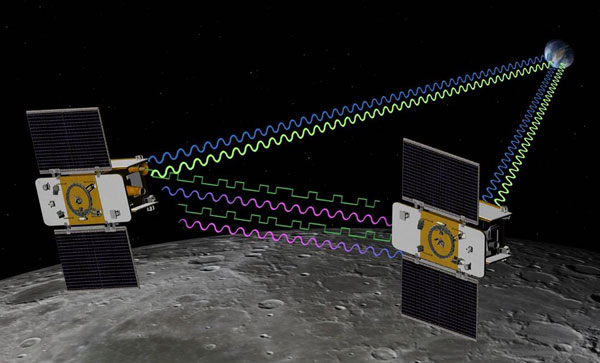NASA sends GRAIL shaped beacon to the Moon

Mynd you, Møøn bites Kan be pretti nasti...
Today, NASA successfully put a new mission into lunar orbit: GRAIL, for Gravity Recovery and Interior Laboratory. Great acronym, weird name, right? What this mission will do is map the gravity field of the Moon, and use that to probe the interior composition. The basic idea isn't all that complicated: fly a probe around the Moon. If it goes above a region where the density is higher, there will be a slightly stronger gravitational pull, and the spacecraft will accelerate a bit. By carefully measuring the spacecraft position and velocity, you can make the lunar gravity map.
In detail, that's a bit tougher! What NASA has done is launch two probes, GRAIL-A and GRAIL-B, that will fly in the same orbit, one behind the other*. They'll stay in constant communication, sending radio pulses to each other. The timing of these pulses allows an extremely accurate determination of their separation: their distance will be known to an accuracy of about a micron: that's a hundredth the width of a human hair, or the size of a red blood cell!
So how does that help? If one of the two probes speeds up or slows down, the radio signal timing will change, taking more or less time to get from one probe to the other. The amount of change is related to the force of gravity felt by the probe, and that in turn is related to the density of the material below. In practice, making a gravity map this way is extremely complex, but it's been done before here at Earth using probes like GRACE and GOCE. It's tried and true.
By mapping out its gravity, we'll be able to essentially probe the material inside the Moon. This will help scientists understand the composition and structure of the Moon's interior, which will in turn help them understand how the Moon formed and perhaps how it's changed over time. We have a pretty good general idea of how the Moon came to be, but more details are always needed for better understanding. GRAIL should provide them.
![]() I'm also personally excited about MoonKAM, a set of four cameras on each probe. These will make high-resolution maps of the lunar surface... but not strictly for science. This is actually part of the Education and Public Outreach for GRAIL designed for middle school (grade 6 - 8) students. They can set up mini-control centers in their classrooms and track where the two GRAIL spacecraft are, getting precise position data. They can then see if the probes will fly over any interesting areas the students want to know more about. They can then write proposals and request the data from NASA itself!
I'm also personally excited about MoonKAM, a set of four cameras on each probe. These will make high-resolution maps of the lunar surface... but not strictly for science. This is actually part of the Education and Public Outreach for GRAIL designed for middle school (grade 6 - 8) students. They can set up mini-control centers in their classrooms and track where the two GRAIL spacecraft are, getting precise position data. They can then see if the probes will fly over any interesting areas the students want to know more about. They can then write proposals and request the data from NASA itself!
That's very cool. I love the idea of letting students get their hands on the actual mission data, and going through the actual process to get it. When they receive those images, they'll know it's because they did the work to obtain them, and their sense of ownership will increase. That's a fantastic motivator to get them interested in the science. And no matter what, I bet it'll be an experience they'll remember their whole lives.
And who knows? A future lunar colonist may get their start in the next few weeks, because they happened to be in a classroom with a direct connection to the Moon.
* As I write this, GRAIL-A is in orbit around the Moon, having successfully arrived on New Year's Eve. GRAIL-B is literally firing its engine right now, and is expected to achieve orbit soon. [UPDATE: GRAIL-B engine firing was a success, and both probes are orbiting the Moon! Congrats to NASA and everyone involved!]





























